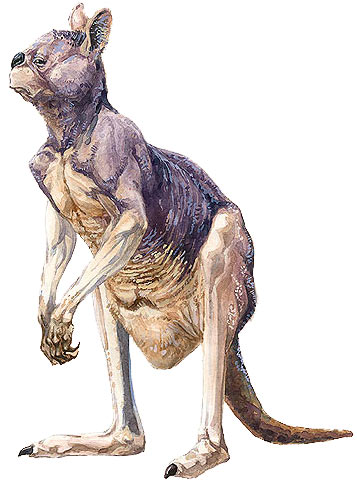
|
Search JoyZine with Google Site Search! |
Giant Short-faced Kangaroo Procoptodon goliah
Procoptodon goliah is now known from all states except Tasmania (although there is one questionable record of Procoptodon from there). As yet, there are no records of Procoptodon from the Northern Territory. In Queensland, P. goliah is known from the Darling Downs in the south-east (the type locality). In New South Wales, P. goliah has been found in three areas, all west of the Dividing Range in the Murray-Darling drainage: from Lake Menindee in the west (the most abundant large kangaroo at the site), Tocumwal near the Murray River, and Bingara in the north-east. In South Australia, Procoptodon goliah is reported from the western Eyre Peninsula and from Naracoorte Caves. The most complete material comes from the recently discovered Nullarbor Plain cave deposits in Western Australia. All sites are interpreted as arid or semi-arid regions. Procoptodon goliah is known from a variety of habitats, mainly semiarid areas of New South Wales and South Australia. Many parts of its range were harsh environments, characterized by vast areas of treeless, wind-blown sand dunes. However, at Lake Menindee in western New South Wales, the climate was cooler and wetter than today, with lake-full conditions and a rich mammalian fauna. The surrounding area was a mosaic of sclerophyll forest, woodland, savannah and plains, yet windblown sand dunes also formed along the edge of the lake. Procoptodon goliah has also been found in cave deposits on the Nullarbor Plain, in an environment interpreted to have been a floristically diverse, dry, open environment dominated by dry sclerophyll vegetation. The complex teeth of Procoptodon goliah tell us that it was a browser rather than a grazer, able to handle the tough leaves and stems typical of arid and semi-arid environments. It would have used its long forelimbs to grasp branches and bring them close for feeding. Like all marsupials, Procoptodon would have had tiny, hairless young that developed to maturity in a pouch after birth. Living kangaroos have unique physiological adaptations (such as embryonic diapause) but it is not known if the extinct sthenurines also shared these adaptations. The type specimen of Procoptodon goliah is a right maxillary fragment with molars M1-3/ in place. The first associated skeletal material came from Lake Menindee, New South Wales. Fossil material has also come from Lake Callabonna in South Australia and, in 2002, several other complete skeletons were found in caves on the Nullarbor Plain. The complete skeleton is now known, and hair and foot impressions have also been found. In areas where it is found with fossils of the red kangaroo, Macropus rufus, fossils of Procoptodon are usually more abundant, suggesting that it was a very successful species until its decline and eventual extinction about 15,000 years ago. Sthenurinae is a subfamily within Macropodidae (the kangaroo family). There were two types of sthenurines: long-snouted (doliocephalic) and short-snouted (brachycephalic) forms. The doliocephalic Hadronomus puckridgei, from Alcoota Station in the Northern Territory, is currently considered the oldest sthenurine. The teeth of sthenurines differ between species, suggesting that the divergence between forms occurred well before the Pleistocene. This would mean that other features may have evolved in parallel. Procoptodon represents the extreme for a brachycephalic sthenurine, with long arms, forward facing eyes and an upright posture. Based on similarities in the dentition, Tim Flannery (1983b) proposed that the closest living relative of sthenurines (short-faced kangaroos) was the tiny banded hare-wallaby (Lagostrophus fasciatus). Still extant, the banded hare-wallaby survives on two islands off the coast of Western Australia. This proposal, however, is debated. Species of Procoptodon are all Pleistocene in age. Valid species of Procoptodon, in addition to P. goliah, include P. pusio and P. rapha. Procoptodon goliah would have overlapped with Aboriginal people for as long as 30,000 years. In New South Wales, Aboriginal people still recount stories of a large, long-armed, aggressive kangaroo that would attack people. Its extinction may have been due to climate shifts during the Pleistocene. |
